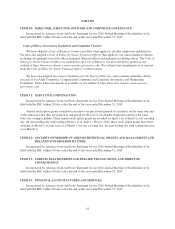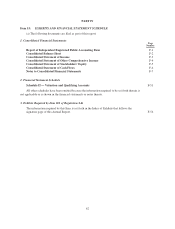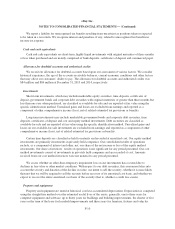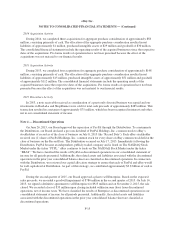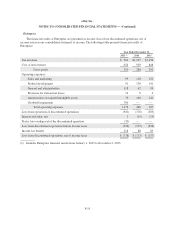eBay 2015 Annual Report Download - page 83
Download and view the complete annual report
Please find page 83 of the 2015 eBay annual report below. You can navigate through the pages in the report by either clicking on the pages listed below, or by using the keyword search tool below to find specific information within the annual report.eBay Inc.
NOTES TO CONSOLIDATED FINANCIAL STATEMENTS — (Continued)
Internal use software and platform development costs
Direct costs incurred to develop software for internal use and platform development costs are capitalized
and amortized over an estimated useful life of one to five years. During the years ended December 31, 2015 and
2014, we capitalized costs, primarily related to labor and stock-based compensation, of $136 million and $144
million, respectively. Amortization of previously capitalized amounts was $110 million, $115 million and $103
million for 2015, 2014 and 2013, respectively. Costs related to the design or maintenance of internal use software
and platform development are expensed as incurred.
Advertising expense
We expense the costs of producing advertisements at the time production occurs and expense the cost of
communicating advertisements in the period during which the advertising space or airtime is used, in each case
as sales and marketing expense. Internet advertising expenses are recognized based on the terms of the individual
agreements, which are generally over the greater of the ratio of the number of impressions delivered over the
total number of contracted impressions, on a pay-per-click basis, or on a straight-line basis over the term of the
contract. Advertising expense totaled $1.0 billion, $1.0 billion and $844 million for the years ended
December 31, 2015, 2014 and 2013, respectively.
Stock-based compensation
We have equity incentive plans under which we grant equity awards, including stock options, restricted
stock units, performance-based restricted stock units, and performance share units, to our directors, officers and
employees. We primarily issue restricted stock units. We determine compensation expense associated with
restricted stock units based on the fair value of our common stock on the date of grant. We determine
compensation expense associated with stock options based on the estimated grant date fair value method using
the Black-Scholes valuation model. We generally recognize compensation expense using a straight-line
amortization method over the respective vesting period for awards that are ultimately expected to vest.
Accordingly, stock-based compensation expense for 2015, 2014 and 2013 has been reduced for estimated
forfeitures. When estimating forfeitures, we consider voluntary termination behaviors as well as trends of actual
option forfeitures. We recognize a benefit from stock-based compensation in equity to the extent that an
incremental tax benefit is realized by following the ordering provisions of the tax law. In addition, we account for
the indirect effects of stock-based compensation on the research tax credit and the foreign tax credit through our
consolidated statement of income.
Provision for transaction losses
Provision for transaction losses consists primarily of losses resulting from our customer protection
programs, fraud and bad debt expense associated with our accounts receivable balance. Provisions for these items
represent our estimate of actual losses based on our historical experience and many other factors including
changes to our customer protection programs, the impact of regulatory changes as well as economic conditions.
Income taxes
We account for income taxes using an asset and liability approach, which requires the recognition of taxes
payable or refundable for the current year and deferred tax liabilities and assets for the future tax consequences of
events that have been recognized in our financial statements or tax returns. The measurement of current and
deferred tax assets and liabilities is based on provisions of enacted tax laws; the effects of future changes in tax
laws or rates are not anticipated. If necessary, the measurement of deferred tax assets is reduced by the amount of
any tax benefits that are not expected to be realized based on available evidence.
F-9


